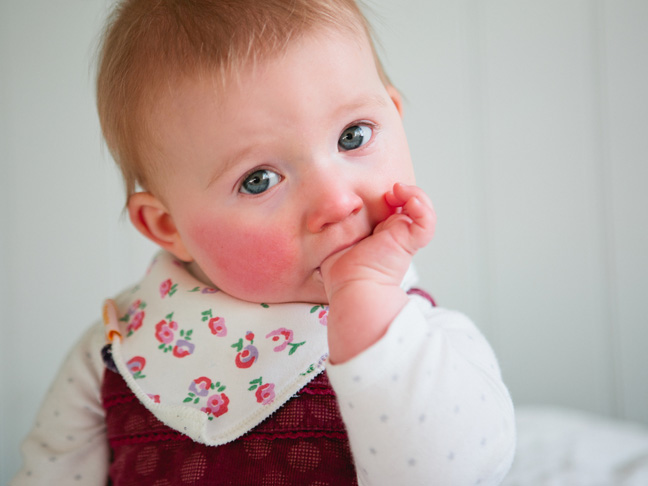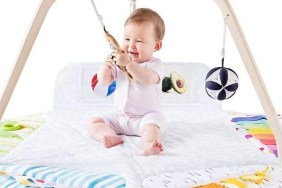As any new mom knows, when it comes to babies, things aren’t always so predictable. When my twin boys were infants, they would have days where their drool was everywhere. I would think, for sure, a tooth is going to pop through any day now. It didn’t though. No, the drooling went on for months, but they didn’t get their first teeth until they were around 10-months-old. And they didn’t come in the “expected” order. Also, aside from the messy diaper and occasional warm flash, teething didn’t seem to bother them all that much either.
Basically, their whole teething experience was out-of-the-box. When I expressed concern that maybe they were missing teeth and that’s why it was taking so long for them to get their chompers, the pediatrician laughed and reassured me that all was fine, that there was a wide range of normal, and that they would have all of their baby teeth by kindergarten. And, he was right; they all ultimately came in, if slowly.
I realized though that there was a lot I didn’t know about teething, aside from the baby-soothing tricks that we shared in our Mommy-and-Me class. If you feel like there’s still a whole lot that you don’t understand about teething, read on…
1. There’s a wide range of normal. While the first tooth tends to come in around 6 months of age, the range can be anywhere from 4 to 15 months of age, according to David M. Krol, MD, a New Jersey-based pediatrician. “I’m usually not concerned until after that time, and by then, the child should have seen their dentist for their first visit,” he says. “It’s important to know that babies who are premature or had low birth weight can have delayed tooth eruption as well.” Still, some babies can have teeth present when they’re born, or not get their first tooth until they’re 18 months old. And some kids don’t get secondary molars until age 3, says Robert Delarosa, DDS, a Baton-Rouge-based pediatric dentist and the former president of the American Academy of Pediatric Dentistry.
2. The teeth tend to pop up in order. There’s a method to the teething madness. “The teeth usually erupt in a pattern, starting with the two bottom front ones, then the two upper front ones. Then, they work their way out, alternating bottom and top, skipping the canine teeth though,” says Dr. Delarosa. “So after those front 8, you have the four baby molars, then the four canines, and then the four second baby molars, for a total of 20 teeth.” For some babies, like mine, the teeth can erupt out of the “normal” sequence which isn’t typically cause for concern.
3. The earlier you get teeth, the earlier you lose them. The later you get them, the later you lose them. Ever heard the old wives’ tale that the earlier you get teeth, the earlier you’ll go through puberty? Yeah, that’s not true, but Dr. Delarosa says he has noticed a correlation between when your teeth come in and when you lose them.
4. Your baby might get cysts in her mouth during teething. They’re known as eruption cycts, and they’re normal. So if you look inside your child’s mouth and see a purplish bump on her gums, don’t panic! “They’re caused by the tooth about to break through the gum,” explains Dr. Delarosa. “While it looks like it would hurt, it doesn’t, and it’s gone once the tooth actually cuts through.”
5. Every kid reacts to teething differently. Unfortunately, there’s no way to really predict how your baby will react to teething. “Some babies experience a lot more distress than others, and have a lot more trouble with erupting teeth, and some have no issues at all,” says Dr. Delarosa. He adds that every tooth eruption can yield different reactions as well.
6. Teething doesn’t necessarily hurt. With all of that furious gnawing and crying we watch our babies go through, you would assume that teething really hurts! As experts point out though, most babies aren’t phased by teeth popping through. “Parents often think their children are in real discomfort, and while this might be true for some babies, you shouldn’t expect to see pain with teething,” says Wendy Sue Swanson, M.D., a pediatrician at Seattle Children’s Hospital and The Everett Clinic, and author of Mama Doc Medicine. “I tend to explain it as babies having ‘itchy’ gums, like they just want to scratch them. You shouldn’t mistake that urge to gnaw as being painful because most likely, it’s not.”
7. Some babies develop tummy troubles while teething. It’s not uncommon for your baby to get some diarrhea while he’s teething. I know that mine did. While some seem to think it’s a result of all of that excess drool, Dr. Swanson says she believes it’s got more to do with the discomfort of teeth coming through; they get a nervous stomach as they cope.
8. Fevers during teething aren’t uncommon either. Some babies can get a small spike in temperature when teeth are pushing through as well, a low-grade systemic response, according to Dr. Swanson. Anything above 100.5 though is a true fever, and likely due to some other culprit. So if baby’s temperature rises that high, talk to your pediatrician.
Phew, that’s a lot, right? And a lot of the teething issues that arise may be ones you don’t think to ask your pediatrician, or don’t even realize are related to those little chompers pushing through. i wish I had more of this info when my boys were teething!








